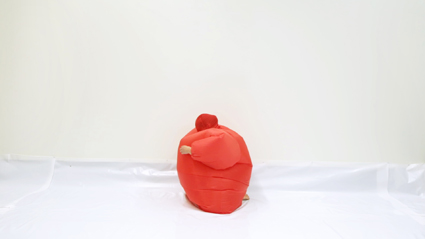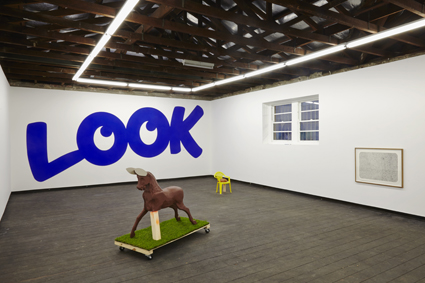Images & icebergs
Holly Williams: The Sceptical Image, SCA Galleries; Bergie Seltzer, Firstdraft

Cherine Fahd, Blown-Up, video still courtesy the artist
Strong political undercurrents rose to the surface in The Sceptical Image, an exhibition of 11 artists interested in unpicking the relationship between contemporary art and documentary practices. Offering new work by academic artists and researchers comprising the Art and the Document research cluster at Sydney College of the Arts, and presented in conjunction with The Image In Question conference, the exhibition sought to locate itself as a generative site for research.
The exhibition pursued a number of critically relevant threads and the politically charged nature of several of the artists’ practices was apparent such as Merilyn Fairskye’s MARCH on the annexation of the Crimea and Janelle Evans’ Eliza Fraser: The Blackening.
Spread across several spaces in the recently repurposed sculpture studios now home to the SCA Galleries, The Sceptical Image’s installation felt rabbit warren-ish in parts and was overshadowed by the vaulted architecture in others. The subtle potency of many of the works was not entirely lost however; Tanya Peterson’s Available Light conjured images of a bushfire smoke-obscured sun from an otherworldly sky. Taken at the start of Summer last year, these images captured nature in a state of imbalance. Peterson commented that on the same day she took them, Australia’s first ever request to activate the International Charter for Space and Major Disasters was made, allowing for satellite data and imagery of the bushfires to be received. Given that Peterson’s practice has been concerned with photography, light and the production of failure this coincidence seemed particularly apt.
On the opposite wall, Justin Trendall’s embroidered Helpless attempted to contravene images elevating industrial progress. Boldly disrupting the monumental modernist forms of factories, silos and skyscrapers using red thread, he undertook an act of resistance to their presence on the landscape and the interlinked economic system that drives them.
Drawing on industrial complexes of a different kind, Margaret Seymour’s Remote Sensing utilised an image of a National Security Agency surveillance compound made freely available by American artist Trevor Paglen. An iteration of her interactive Tracker robotic video works, Remote Sensing created an elusive experience for the viewer as it moved across the gallery floor, echoing the slippery and secretive way mass surveillance operates in today’s society.
Stefan Popescu’s engaging (un)identified contended with the speculative and the absurd as it highlighted the supposed concurrence of football and unidentified flying objects in Australia. His use of Tom Drury’s 1953 grainy UFO-capturing match footage (which has been called “the holy grail of Australian ufology”) served to destabilise not only the concept of truth in historical documentation but also notions of nation-building as they coalesce around male sports.
One of the most striking pieces was Blown-Up by Cherine Fahd. The twisted ‘selfie’ performance video challenged the viewer with the awkward political incorrectness of gazing at a person dancing in a fat suit. Blown-Up encapsulated the trajectory of humans looking at other humans—from Eadweard Muybridge’s early studies, politically contested images of prisoners and so-called degenerates, to reality TV and YouTube videos.

Kenzee Patterson, Bergie Seltzer, Firstdraft
Firstdraft: Bergie Seltzer
Across town at Firstdraft’s new space in Woolloomooloo, seven predominantly Sydney College of the Arts alumni presented the self-curated group exhibition, Bergie Seltzer. In contrast to the hodgepodge of works that can typify such endeavours, Bergie Seltzer was a well thought out, cohesive exhibition.
Borrowing from 20th century artistic tropes—pop, ready-made and text-based forms—and born from a shared appreciation of each other’s practices, the exhibition as a whole could be read as a conversation among artists, filled with witty one-liners and lines ripe to be read between.
While the title might have pointed towards the ‘thought bubble’ over the spoken word (bergie seltzer is the fizzing sound generated by trapped air being released from a melting iceberg), the exhibition elucidated matters of language and modes of communication through its inclusion of writing instruments, signage, advertising and broadcast content.
Due to their deft, interwoven arrangement in the space, many of the works entered a dialogue with one another. Playful tensions could be sensed however as the bright, colourful works vied for the viewer’s attention. Kenzee Patterson’s large wall text, Look, implored the viewer in deep Kleinean blue at the far end of the gallery behind Ben Terakes’ scatalogical Broken chair with poo and Frankensteined rocking horse after the late American artist Jason Rhoades. In front of this were two of the quieter, and possibly more nuanced, works in the show: Patterson’s Return to Form sculptures, a pair of sinuous ampersand forms teased out of a bar of galvanised steel reinforcement—a material prized for its rigidity and capacity to enable multi-storey construction.
Simpatico among the artists could be found in the adjacent room as Kevin Platt’s curly bracketed neon lips, Scripture/Cable Management, smiled benignly at Sean Rafferty’s suntanned plywood Fady Lingers (a word play on Lady Fingers and fruit and vegetable boxes) while in the opposite corner Will French’s bright yellow inflatable figure, an appropriated marketing character, rose with a kind of manic optimism and fell with a pathetic impotence.
In an exhibition that also celebrated materiality and process, French’s ink on paper TVSNOW took two years to complete. Produced while he was watching television, French painstakingly carved eucalyptus twigs into pixel shaped stamps and used their impressions to build a picture of screen static. Given that TV snow contains traces of cosmic radiation from the Big Bang more than 13 billion years ago, this work was a particularly poetic homage to the analogue signal as it fades from view in the digital age.
Echoing this, Emma White’s Waste of Potentia pondered the value of the individual gesture with a seemingly discarded pencil and eraser and a slight, pathos-filled sentence. “I was here” initially appeared to have been scrawled on the gallery wall by some anonymous vandal but, typical of White’s work, was an artistic facsimile laboriously rendered from polymer clay.
Both The Sceptical Image and Bergie Seltzer reinvigorate the at times facile discussions around artist-organised exhibitions and the sophisticated exchanges they have with one another about and through their work. As with icebergs there is always much more going on below the surface.
The Sceptical Image: Ryszard Dabek, John Di Stefano, Janelle Evans, Cherine Fahd, Merilyn Fairskye, Anne Ferran, Tanya Peterson, Stefan Popescu, Margaret Seymour, Yanai Toister and Justin Trendall, SCA Galleries, Sydney College of the Arts, Lilyfield, 2-30 Aug; Bergie Seltzer: Will French, Kevin Platt, Sean Rafferty, Kenzee Patterson, Kate Mitchell, Ben Terakes, Emma White, Firsdraft Gallery, Woolloomooloo, Sydney, 23 July-15 Aug
RealTime issue #123 Oct-Nov 2014 pg. 49






